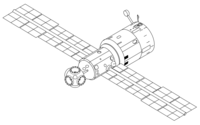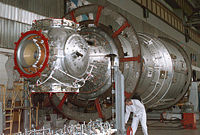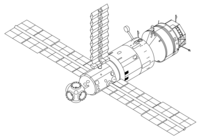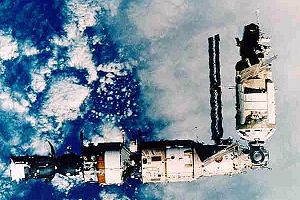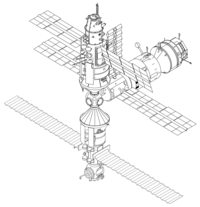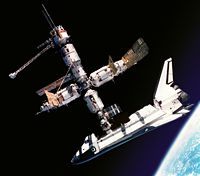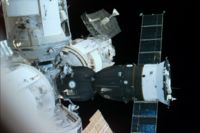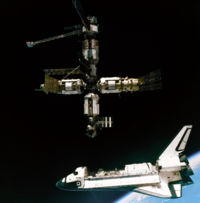Mir
2008/9 Schools Wikipedia Selection. Related subjects: Space transport
| Station Mir | ||
|---|---|---|
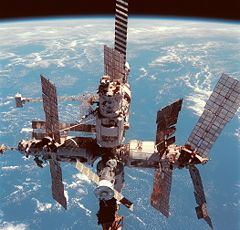 |
||
| Mir following separation from the Space Shuttle Discovery, June 12, 1998 | ||
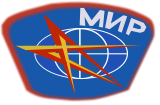 |
||
| Station statistics | ||
| Call sign: | Mir | |
| Crew: | 3 | |
| Launch: | 1986- 02-19 21:28:23 UTC |
|
| Launch pad: | LC200/39, Baikonur Cosmodrome, USSR |
|
| Reentry: | 2001- 03-23 05:50:00 UTC |
|
| Mass: | 124,340 kg (274,123 lbs) |
|
| Living volume: | 350 m³ | |
| Perigee: | 386 km (207.9 nmi) | |
| Apogee: | 398 km (212.5 nmi) | |
| Orbit inclination: | 51.6 degrees | |
| Orbital period: | 89.8 minutes | |
| Orbits per day: | 16.13 | |
| Days in orbit: | 5,519 days | |
| Days occupied: | 4,592 days | |
| Distance travelled: | 3,638,470,307 km (1,964,616,800 nmi) |
|
| Statistics as of Deorbit on 2001- 03-23. | ||
| Configuration | ||
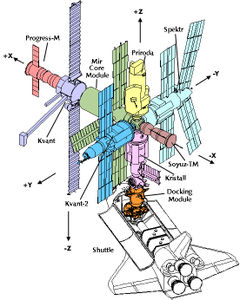 |
||
| Final configuration of Mir, with docked Space Shuttle | ||
| Station Mir | ||
Mir (Russian: Мир, which can mean both Peace and World, and was the name given to peasant communes in pre-revolutionary Russia) was a Soviet (and later Russian) orbital station. Mir was the worlds first consistently inhabited long-term research station in space, and the first 'third generation' type space station, constructed over a number of years with a modular design.
Mir holds the record for longest continuous human presence in space at eight days short of 10 years, and, through a number of collaborations, was made internationally accessible to cosmonauts and astronauts of many countries. The most notable of these, the Shuttle-Mir Program, saw American Space Shuttles visiting the station eleven times, bringing supplies and providing crew rotation. Mir was assembled in orbit by successively connecting several modules, each launched separately from 1986 to 1996.
The station existed until 23 March 2001, when it was deliberately de-orbited, breaking apart during atmospheric re-entry over the South Pacific Ocean.
Development
Mir was authorized as part of the third generation of Soviet space systems in a February 17, 1976 decree to design an improved model of the Salyut DOS-17K space station. Four Salyut space stations had already been launched since 1971. Three more were launched during the development of Mir. At the time it was planned that the base blocks ( DOS-7 and DOS-8) would be equipped with a total of four docking ports: two at either end of the station as with the Salyut stations, and an additional two ports on either side of a docking sphere at the front of the station. By August 1978, this had evolved to the final configuration of one aft port and five ports in a spherical compartment at the forward end of the station.
It was originally planned that the ports would connect to 7.5 tonne modules derived from the Soyuz spacecraft. These modules would have used a Soyuz propulsion module, as in Soyuz and Progress, and descent module and orbital module would have been replaced with a long laboratory module.
The Mir program was consolidated with Vladimir Chelomei's manned Almaz military space station program in a February 1979 resolution. The docking ports were reinforced to accommodate 20 tonne space station modules based on the TKS spacecraft. NPO Energia was responsible for the overall space station; however, work was subcontracted to KB Salyut, the development arm of the Khrunichev due to ongoing work on Energia, Salyut 7, Soyuz-T, and Progress spacecraft. KB Salyut began work in 1979, and drawings were released in 1982-1983. New systems incorporated into the station included the Salyut 5B digital flight control computer and gyrodyne flywheels (taken from Almaz), and the new Kurs automatic rendezvous system, Altair satellite communications system, Elektron oxygen generators, and Vozdukh carbon dioxide scrubbers.
By early 1984 work on Mir had ground to a halt while all resources were being put into the Buran program to get the Buran space shuttle ready for flight test. Funding was returned in early 1984 when Valentin Glushko was ordered by the Central Committee's Secretary for Space and Defense to orbit Mir by early 1986, in time for the 27th Communist Party Congress.
It was clear that the planned processing flow could not be followed and still make the 1986 launch date. It was decided on Cosmonaut's Day (April 12) to ship the flight model to Baikonur and conduct the systems testing and integration there. Mir arrived at the launch site on May 6, 1985. 1100 of 2500 cables required rework based on the results of tests to the ground test model at Khrunichev. In October Mir was rolled outside its cleanroom. The first launch attempt on February 16, 1986 was scrubbed when the spacecraft communications failed. The second attempt on February 19, 1986 at 21:28:23 UTC was successful, meeting the political deadline.
Early existence
Due to the pressure to launch the station in such short order, mission planners were left without Soyuz spacecraft or modules to launch to the station at first. It was decided to launch Soyuz T-15 on a dual mission to both Mir and Salyut 7.
Leonid Kizim and Vladimir Solovyov first docked with the Mir space station on March 15, 1986. During their nearly 51-day stay on Mir, they brought the station online and checked its systems. They also unloaded two Progress spacecraft launched after their arrival, Progress-25 and Progress-26.
On May 5, 1986 they undocked from Mir for a day-long journey to Salyut-7. They spent 51 days there and gathered 400 kg of scientific material from Salyut 7 for return to Mir. While Soyuz T-15 was at Salyut-7, the unmanned Soyuz TM-1 arrived at the unoccupied Mir and remained for 9 days, testing the new Soyuz TM. Soyuz T-15 redocked with Mir on June 26 and delivered the experiments and 20 instruments, including a multichannel spectrometer. The EO-1 crew spent their last 20 days on Mir conducting Earth observations before returning to earth on July 16, 1986, leaving the new station unoccupied.
The second expedition to Mir, Mir EO-2, launched on Soyuz TM-2 on February 5, 1987. During their stay, the Kvant-1 module was launched on March 30, 1987. It was the first, experimental version of a planned series of '37K' modules scheduled to be launched to Mir on the Soviet Buran space shuttle. Kvant-1 was originally planned to dock with Salyut 7; however, due to technical problems during its development, it was reassigned for Mir. The module carried the first set of six gyroscopes for attitude control. The module also carried instruments for X-ray and ultraviolet astrophysical observation.
The initial rendezvous of the Kvant-1 module with Mir on April 5th 1987 was troubled by the failure of the onboard control system. After the failure of the second attempt to dock, the onboard cosmonauts, Yuri Romanenko and Aleksandr Laveykin, conducted a spacewalk to fix the problem. They found a trash bag between the module and the station, which prevented the docking. The bag was left in orbit after the departure of one of the cargo ships. They removed the bag and completed docking on April 12th.
The Soyuz TM-2 launch was the beginning of a string of 6 Soyuz launches and three long-duration crews between February 5, 1987 and April 27, 1989. This time period also saw the first international visitors to the station, Muhammed Faris, Abdul Ahad Mohmand and Jean-Loup Chrétien. With the departure of Mir EO-4 on Soyuz TM-7 April 27, 1989 the station was once again left unoccupied.
First expansion phase
The launch of Soyuz TM-8 on September 5, 1989 marked the beginning of the longest human presence in space to date. It also marked the beginning of Mir's second expansion. The Kvant-2 and Kristall modules were now ready for launch. Alexander Viktorenko and Aleksandr Serebrov docked with Mir and brought the station out of its five-month hibernation. On September 29 the cosmonauts installed equipment in the docking system in preparation for the arrival of Kvant 2, the first of the 20-ton add-on modules based on the TKS spacecraft from the Almaz program
After a delay of 40 days due to problems with a batch of computer chips, Kvant-2 was launched on November 26. After problems deploying the craft's solar array and with the automated docking systems on both Kvant-2 and Mir, Kvant-2 was docked manually on December 6. Kvant-2 added a second set of gyrodines to Mir. The module also carried the new life support systems for recycling water and generating oxygen on board Mir, reducing its dependence on resupply from the ground. Kvant-2 also featured a large airlock with a one-meter hatch. A special backpack unit, an equivalent of the U.S. Manned Maneuvering Unit, was located inside Kvant-2's airlock.
Soyuz TM-9 launched Mir EO-6 crew members Anatoly Solovyev and Aleksandr Balandin on February 11, 1990. While docking, the EO-5 crew on board Mir saw that 3 thermal blankets on the Soyuz-TM 9 were loose, potentially creating problems on reentry. It was decided that this would be manageable. Their stay on board Mir saw the addition of the Kristall module. The module was launched on May 31. The first docking attempt on June 6 was aborted due to an attitude control thruster failure. The Kristall module arrived at Mir’s front port on June 10, and was relocated to the lateral port opposite Kvant-2 the next day, restoring the equilibrium of the complex. Due to the delay in the docking of Kristall, EO-6 was extended by 10 days to permit the activation of Kristall’s systems, and to accommodate the EVA to repair the loose thermal blankets on Soyuz-TM 9.
The Kristall module contained a number of furnaces for the creation of crystals in micro-gravity. Also on board was biotechnology research equipment, including a small greenhouse for plant cultivation experiments. The unit was equipped with a source of light and a feeding system. The module also contained equipment for astronomy observations. The main feature, however, was the two APAS-89 Androgynous Peripheral Attach System docking ports designed to be compatible with the Buran shuttle. Although they were never used with a Buran Shuttle, they were later used with the American Space Shuttle.
The EO-7 relief crew arrived aboard Soyuz TM-10 on August 3, 1990. The new crew arrived at Mir with quail for Kvant-2's cages. A quail laid an egg en route to the station. It was returned to Earth, along with 130 kg of experiment results and industrial products, in Soyuz TM-9. Three more expeditions continued to visit Mir while tensions back on Earth grew. The Mir EO-10 crew launched aboard Soyuz TM-13 on October 2, 1991 was the last crew to launch from the USSR, and continued the occupation of Mir through the fall of the Soviet Union. The unlaunched modules, Spektr and Priroda, were not so lucky. The newly formed Russian Federal Space Agency was unable to finance them and they were put into storage, ending Mir's first expansion.
International cooperation
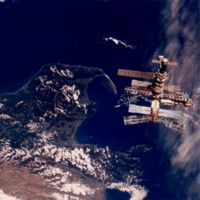
In September 1993 U.S. Vice-President Al Gore and Russian prime minister Viktor Chernomyrdin announced plans for a new space station, which would later be called the International Space Station, or ISS. They also agreed that, in preparation for this new project, the U.S. would be involved in the Mir project in the years ahead, under the code name Phase One (the ISS being Phase Two). Space shuttles would take part in the transport of supplies and people to and from Mir, and American astronauts would live on Mir for many months on end, allowing the U.S. to share and learn from the unique experience that Russia had with long duration space flights.
The U.S. involvement in the Mir program also brought new funds to Mir. The most notable use of these was the completion and launch of the Spektr and Priroda modules. Also, the Mir Docking Module was constructed to make the process of docking the shuttle to the station easier.
Starting in March 1995, seven U.S. astronauts spent 28 months on Mir. During their stay several acute emergencies occurred, notably a small fire on February 23, 1997, and a collision with an unmanned Progress spacecraft on June 25, 1997. The latter left a hole in the Spektr module, which was then sealed off from the rest of the station. On both occasions the necessity for complete evacuation using the Soyuz escape craft was narrowly avoided. Several space walks were needed to restore full power to Mir, and one of these was inside the Spektr module from which all the air had escaped. After the emergencies, the U.S. Congress and NASA considered whether the U.S. should abandon the program out of concern for the astronauts' safety, but NASA administrator Daniel S. Goldin decided to continue the program.
In June 1998, the final U.S. Mir astronaut Andy Thomas left the station aboard the Space Shuttle Discovery.
Mir was originally planned to be followed by a Mir 2, and elements of that project are now an integral part of the International Space Station, including the core module (now called Zvezda) which was labeled as "Mir-2" for quite some time in the factory.
Life on Mir
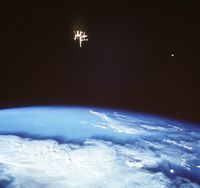
Inside, the 100-ton Mir looked like a cramped labyrinth, crowded with hoses, cables and scientific instruments — as well as articles of everyday life, such as photos, children's drawings, books and a guitar. It commonly housed three crew members, but it sometimes supported as many as six for up to a month. Except for two short periods, Mir was continuously occupied until August 1999.
Two amateur radio call signs, U1MIR and U2MIR, were assigned to Mir in the late 1980s, allowing radio operators on Earth to communicate with the cosmonauts.
Peter Llewellyn almost visited Mir in 1999 after promising US$100 million for the privilege.
Final days and deorbit
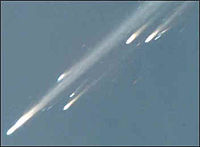
Near the end of its life, there were plans for private interests to purchase Mir, possibly for use as the first orbital television/ movie studio. The privately-funded Soyuz TM-30 mission, launched on April 4, 2000, carried two crew members, Sergei Zalyotin and Alexandr Kaleri, to the station for two months to do repair work with the hope of proving that the station could be made safe. But this was to be the last manned mission to Mir. While Russia was optimistic about Mir's future, its commitments to the International Space Station project left no funding to support the aging Mir.
Mir's deorbit was done in three stages. The first stage was waiting for atmospheric drag to decay Mir’s orbit an average of 220 kilometers (137 mi). This began with the docking of Progress M1-5, a modified version of the Progress M carrying 2.5 times more fuel in place of supplies. The second stage was the transfer of the station into a 165 x 220 km (103 x 137 mi) orbit. This was achieved with two burns of the Progress M1-5's control engines at 00:32 UTC and 02:01 UTC on March 23, 2001. After a two-orbit pause, the third and final stage of Mir's deorbit began with the burn of Progress M1-5's control engines and main engine at 05:08 UTC, lasting a little over 22 minutes. Reentry into Earth's atmosphere (100 km/60 mi) of the 15-year-old space station occurred at 05:44 UTC near Nadi, Fiji. Major destruction of the station began around 05:52 UTC and the unburned fragments fell into the South Pacific Ocean around 06:00 UTC.
In anticipation of the reentry of Mir, the owners of Taco Bell towed a large target out into the Pacific Ocean. If the target was hit by a falling piece of Mir, every person in the United States would be entitled to a free Taco Bell taco. The company bought a sizable insurance policy for this "gamble." No piece of the station struck the target.
NASA created an animation of the Mir deorbit.
Support craft
The Mir space station was primarily supported by the Russian Soyuz and Progress spacecraft. Soyuz craft provided manned access to and from the station, allowing for crew rotations. Soyuz craft also functioned as a lifeboat for the station, allowing for a relatively quick return to earth in the event of an emergency. The unmanned Progress cargo vehicles were only used to resupply the station and were incapable of surviving reentry.
It was anticipated that it would also be the destination for flights by the later-abandoned Buran space shuttle. The Kristall module even carried two APAS-89 Androgynous Peripheral Attach System docking ports designed to be compatible with the Buran shuttle. These were later used with the American Space Shuttle.
During the Shuttle-Mir Program, Mir was also supported by Space Shuttles, allowing American and other western astronauts to visit or stay long-term on the station. The visiting US shuttles used a modified docking collar originally designed for the Soviet Buran shuttle, mounted on a bracket originally designed for use with Space Station Freedom. A Docking Module was later added to the end of Kristall to eliminate the need to move the module and retract solar arrays for clearance issues. The shuttles provided crew rotation of the U.S. astronauts on station as well as carrying cargo to and from the station, performing some of the largest transfers of cargo of the time. With a space shuttle docked to Mir the temporary enlargements of living and working areas amounted to a complex that was the largest spacecraft in history at that time, with a combined mass of 275 tons (227 metric tonnes).
Mir modules
The Mir space station was constructed by connecting seven different modules, each launched into orbit separately by a Proton rocket, except for the Docking Module, which was brought to Mir by a Space Shuttle.
| For more information about the modules, visit the module pages linked on the table below. |
| Module | Launch Date | Launch vehicle | Docking Date | Mass | Soyuz | Purpose | Isolated view | Mir Configuration | Photo |
|---|---|---|---|---|---|---|---|---|---|
| Core | February 19, 1986 | Proton 8K82K | N/A | 20,100 kg (44,313 lb) | N/A | Main station living quarters, core of entire station to which all other modules were docked. |  |
 |
|
| Kvant-1 | March 31, 1987 | Proton 8K82K | ~ April 9, 1987 | 10,000 kg (22,046 lb) | TM-2 | Astronomical observations and Material Science experiments. |  |
 |
 |
| Kvant-2 | November 26, 1989 | Proton 8K82K | December 6, 1989 | 19,640 kg (43,299 lb) | TM-8 | Newer, more sophisticated life support systems, extra scientific experiments and an airlock. |  |
 |
|
| Kristall | May 31, 1990 | Proton 8K82K | June 10, 1990 | 19,640 kg (43,299 lb) | TM-9 | Technology, material processing, geophysics and astrophysics laboratory. |  |
 |
|
| Spektr | May 20, 1995 | Proton 8K82K | June 1, 1995 | 19,640 kg (43,299 lb) | TM-21 | Housed experiments for the Shuttle-Mir Program. |  |
 |
 |
| Docking Module | November 12, 1995 | Space Shuttle Atlantis ( STS-74) | November 15, 1995 | 6,134 kg (13,523 lb) | TM-22 | Used as a docking port for the American Space Shuttle during the Shuttle-Mir Program. |  |
 |
|
| Priroda | April 23, 1996 | Proton 8K82K | April 26, 1996 | 19,000 kg (41,888 lb) | TM-23 | Remote Earth sensing module. |  |
 |
 |
